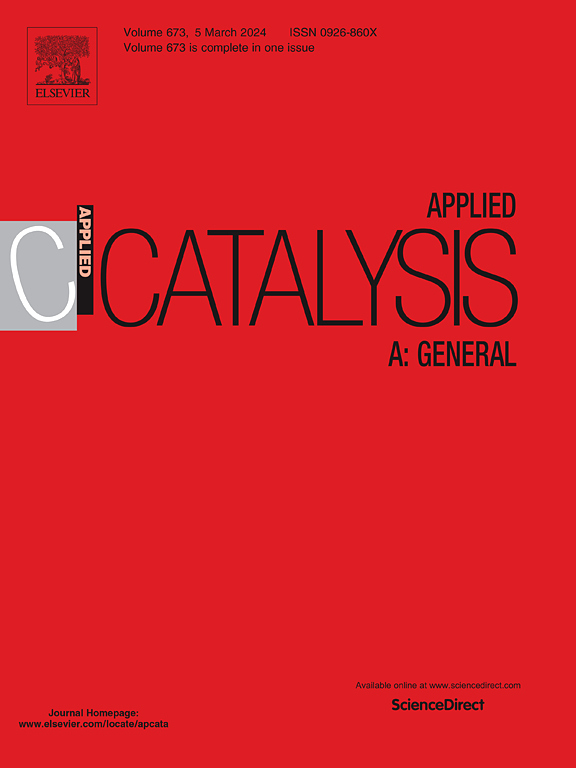Solvent-free phosphorus modification of Pt/Al2O3 catalysts to improve dispersion and dehydrogenation activity
IF 4.7
2区 化学
Q2 CHEMISTRY, PHYSICAL
引用次数: 0
Abstract
This study introduces a solvent-free gas-phase method for modifying Al₂O₃-supported platinum (3 wt%) catalysts with phosphorus (P) to enhance Pt dispersion and dehydrogenation activity. The process involves decomposing NaH₂PO₂ at 600 °C, releasing PH₃, interacting with Pt on the catalyst surface. P-modified catalysts showed up to a 24 % increase in activity for perhydro-benzyltoluene dehydrogenation within a P:Pt ratio of 0.6–2.6. Additionally, they exhibited high resistance to sintering, maintaining Pt particle sizes of ∼0.9 nm even at 600 °C. Characterization using CO chemisorption, STEM NMR, and XPS revealed that PH₃ deposits phosphorus on the catalyst, which then oxidizes via support lattice oxygen. At 600 °C, this oxidized phosphorus migrates to the support/metal interface, stabilizing Pt nanoparticles and preventing sintering. However, when the P:Pt ratio exceeds 2.6, excess phosphorus remains on the surface, deactivating active sites. This study highlights the role of POₓ species in stabilizing Pt nanoparticles and optimizing catalyst performance.
无溶剂磷改性Pt/Al2O3催化剂,提高分散性和脱氢活性
介绍了一种无溶剂气相法,用磷(P)修饰Al₂O₃负载铂(3 wt%)催化剂,以提高铂的分散性和脱氢活性。该过程包括在600℃下分解NaH₂PO₂,释放PH₃,与催化剂表面的Pt相互作用。P:Pt比为0.6 ~ 2.6时,P改性催化剂的过氢苄基甲苯脱氢活性提高了24% %。此外,它们表现出高的耐烧结性,即使在600°C下也能保持Pt粒度为~ 0.9 nm。利用CO化学吸附、STEM NMR和XPS进行表征表明,PH₃将磷沉积在催化剂上,然后催化剂通过支撑晶格氧氧化。在600℃时,氧化磷迁移到载体/金属界面,稳定Pt纳米颗粒并防止烧结。然而,当P:Pt比超过2.6时,多余的磷留在表面,使活性位点失活。本研究强调了POₓ在稳定Pt纳米粒子和优化催化剂性能中的作用。
本文章由计算机程序翻译,如有差异,请以英文原文为准。
求助全文
约1分钟内获得全文
求助全文
来源期刊

Applied Catalysis A: General
化学-环境科学
CiteScore
9.00
自引率
5.50%
发文量
415
审稿时长
24 days
期刊介绍:
Applied Catalysis A: General publishes original papers on all aspects of catalysis of basic and practical interest to chemical scientists in both industrial and academic fields, with an emphasis onnew understanding of catalysts and catalytic reactions, new catalytic materials, new techniques, and new processes, especially those that have potential practical implications.
Papers that report results of a thorough study or optimization of systems or processes that are well understood, widely studied, or minor variations of known ones are discouraged. Authors should include statements in a separate section "Justification for Publication" of how the manuscript fits the scope of the journal in the cover letter to the editors. Submissions without such justification will be rejected without review.
 求助内容:
求助内容: 应助结果提醒方式:
应助结果提醒方式:


